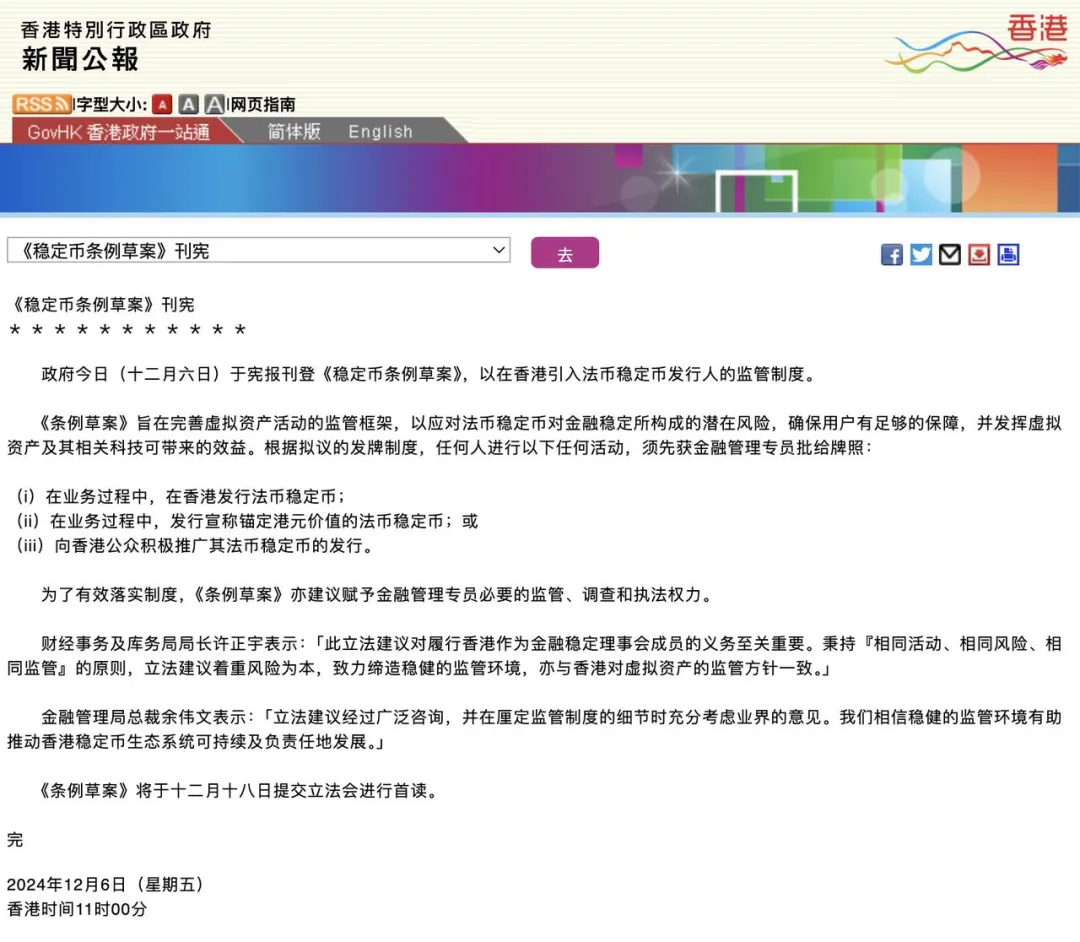Web3 Lawyer: Hong Kong’s latest stablecoin bill, innovation catalyst or regulatory shackles?

Reprinted from panewslab
12/23/2024·5Mintroduction
On December 6, 2024, Hong Kong took an important step in the digital asset industry by promulgating the groundbreaking Stablecoin Act. The move underscores Hong Kong’s ambition to solidify its position as a global leader in digital asset regulation and sets a benchmark for other jurisdictions grappling with the complexities of this emerging market.

▲Screenshots of related news
Often hailed as a bridge between traditional finance and blockchain technology, stablecoins have grown rapidly globally, driven by the price stability they offer and the potential for applications in payments, remittances and decentralized finance. Widely used. However, the lack of comprehensive regulation exposes the vulnerabilities of stablecoins, ranging from systemic risks to consumer protection issues, forcing policymakers to take action.
The proposed legislation seeks to strike a delicate balance: ensuring financial stability and protecting public trust while driving growth in the Web3 economy. But can it succeed in achieving this goal? This article will provide an in-depth analysis of whether this framework can be consistent with Hong Kong’s dual goals of innovation and caution in the rapidly developing stablecoin market.
The need for regulation
Regulation of fiat-pegged stablecoins (“FRS”) is critical to promoting a safe and innovative financial ecosystem. A major benefit of regulatory transparency is increased investor confidence. By setting clear rules, regulators can ensure that stablecoin issuers operate more transparently, thereby reducing the risk of fraud or mismanagement and attracting institutional and retail investors who might otherwise be hesitant.
In addition, the regulation of stablecoins plays a key role in preventing systemic risks. Stablecoins, especially those pegged to fiat currencies, are increasingly integrated into the financial system and become a vehicle for payments, transactions and liquidity management. Without regulation, issues such as sudden redemptions, operational failures or reliance on volatile collateral could ripple through traditional financial markets, affecting broader economic stability.
Regulation also promotes alignment with global standards, enabling cross-border interoperability and enhancing trust among international stakeholders. The European Union has passed the "Crypto-Asset Market (MiCA)" regulations, and the United States is also conducting legislative discussions on stablecoins and is moving towards formulating a regulatory framework. The passage of Hong Kong’s proposed law is consistent with these efforts to set a benchmark for responsible innovation globally.
As a renowned financial centre, Hong Kong's adoption of this legislation further solidifies its position as a gateway between East and West. By prioritizing investor protection, financial stability and regulatory consistency, this initiative strengthens Hong Kong’s position as a forward-looking, globally competitive financial center and attracts innovators and investors in the Web3 space.
Challenges and Tradeoffs
As Hong Kong seeks to become a leader in stablecoin regulation, the proposed framework faces key challenges and trade-offs. These challenges include how to balance strict regulation with the promotion of innovation, and navigate the rapid development of the digital asset ecosystem in a complex environment of global coordination.
Potential barriers to innovation
The Stablecoin Act imposes strict licensing and compliance requirements on fiat-pegged stablecoins (FRS). While this approach is critical to ensuring transparency, consumer protection and system stability, it risks excluding smaller or emerging market players. Startups are often a hotbed of innovation in the Web3 space, but they can struggle due to high audit fees, strict governance requirements and capital adequacy requirements.
For example, the EU's MiCA framework contains detailed compliance obligations. In order to avoid these burdens, some startups choose to relocate their companies to less regulated regions, such as Switzerland or Dubai. Hong Kong could face similar challenges if its regulatory costs are deemed too high, driving away talent and innovation.
Additionally, there is a risk of regulatory capture, whereby the market may be dominated only by large, well-resourced players. In the United States, for example, major players such as Circle (issuer of USDC) have lobbied for stricter rules that may be difficult for smaller competitors to meet. If Hong Kong develops along this trajectory, it may form an oligopolistic market that inhibits innovation in stablecoin design or application.
The role of global coordination
Due to the nature of their cross-border operations, stablecoins require consistency in global regulatory frameworks to unleash their full potential. Different regulatory frameworks have posed challenges in the past. For example, the United States’ evolving approach to stablecoin regulation — which emphasizes bank-level reserve requirements — differs significantly from Japan’s system, which only allows licensed banks and trust companies to issue stablecoins. This fragmented regulatory system hinders interoperability and reduces the utility of stablecoins in international trade and remittances.
Hong Kong needs to navigate these complex issues carefully. As a gateway between China and the global financial system, Hong Kong has a unique opportunity to align with global standards, such as MiCA or the Financial Stability Board’s recommendations for stablecoins. However, if they fail to align with international standards, local issuers in Hong Kong may face isolation, affecting their interaction with the international market. Instead, a flexible yet internationally aligned framework would enhance Hong Kong’s reputation as a trustworthy digital asset hub.
Mankiw Lawyer Summary
Hong Kong’s Stablecoins Bill marks an important moment in the development of digital asset regulation and reflects Hong Kong’s ambition to lead in this transformative industry. By emphasizing transparency, stability, and investor protection, the legislation lays a solid foundation for the stablecoin ecosystem to thrive. However, the bill's success relies on finding a delicate balance between protecting financial integrity and promoting innovation.
This issue is of great significance - not only to Hong Kong, but also to the global stablecoin market. Will this framework become a beacon of regulatory excellence, promoting innovation while ensuring stability, or will it become a cautionary tale where excessive restrictions stifle growth and drive opportunities elsewhere?
The answer lies in execution, adaptability and global collaboration. The world is watching and Hong Kong has the opportunity to set the gold standard in the industry.



 jinse
jinse
 chaincatcher
chaincatcher